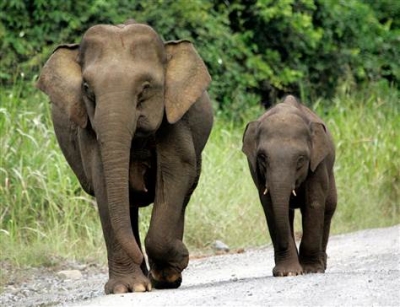
The Borneo elephant also known as the Borneo pygmy elephant (Elephas maximus borneensis) is unique to the forests of northeastern Borneo, Malaysia and Indonesia.
Rotund appearance
As its name implies, it is the smallest subspecies of the Asian elephant. Just under 8 foot tall, these elephants have large ears round belies, and long tails, so long that they could even brush the ground as they walk. The females are smaller than the males and either have tiny tusks or none at all. At the end of their long trunk is a single, prehensile finger, which it uses to collect grasses, leaves, fruits and other plants. Reaching down for a drink of water is easy too. One adult can eat up to 150 kg of vegetation per day. Favourite food? Of course, it’s durian and wild bananas which are common in its habitat.
Gentle nature
Borneo elephants are gentler compared to Asian and African elephants. In fact, there are very tame and quite passive, which has led some to believe that they once belonged to a domesticated herd. The story goes that in the 17th Century, the Sultan of Sulu was given a collection of captive elephants, and these were released into the jungles of Borneo. Scientific evidence by way of DNA studies shows that Borneo elephants are local to the region. Their lifespan is anywhere between 50 and 70 years.
Matriarchal system
Borneo elephants are sociable animals and live in matriarchal hierarchy. They form small groups of 8 individuals on average, which are dominated by females. Families typically comprise mothers, daughters, sisters and immature males (occasionally – an adult male). Mature males tend to be solitary or form temporary bull herd.
Behaviour
Family units occasionally gather together. This association is highly beneficial for them, helping keep genetic diversity, which, in turn, is vital for their survival. These active elephants are known to wander throughout their habitat, travelling up to 25-30 miles a day. Borneo elephants are migratory animals. Seasonal migration helps them keep themselves in good physical shape. They are good swimmers too.
Breeding
Calves are born after a gestation of 19-22 months. Only one calf is born. Elephants give birth about every 4-6 years, although this period may be extended when conditions are unfavourable for survival, such as during drought. The little one is fed by its mother till the age of three or four. It is the centre of attention among a herd.
Endangered
Pygmy elephants are an endangered species with barely around 1,500 individuals left in the wild, mostly found in Sabah in Malaysian Borneo. The primary threat to these elephants is habitat loss. As human encroachment wipes out forests, the herds are no longer able to travel along their traditional migration routes and sources of food. These homeless elephants also get killed in conflicts when they enter farmland and trample on crops are eat them up. Some get caught in snares erected by humans to trap other animals.
Hence, conserving forests and maintaining elephant corridors is essential if these elephants are to be saved from becoming extinct.
Quick facts
- Borneo Pygmy elephants are native to Borneo Island.
- They are smaller than African elephants.
- They belong to Elephantidae family.
- Their average life expectancy is in the range of 60-75 years.
- They are cute and baby-faced.
- The female can grow to a height of around 4 to 7 feet.
- Males grow up to a height of around 7 to 8.2 feet.
- They weight between 3000 – 5000kg.
- They are usually grey, but occasionally the colour varies from brownish to blackish grey.
Picture Credit : Google

